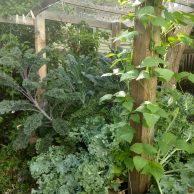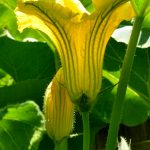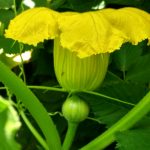
We have been getting questions from customers about some of the vegetables in their gardens. Here are questions and answers about squash pollination and the many uses of fennel.
Q: Why did the first fruits of my squash plants fail to enlarge and ultimately turn yellow and fall off the plant?
A: Squash and other crops in the Cucurbitaceae family (known as Cucurbits), like cucumbers, melons, gourds and pumpkins, bear separate male flowers and female flowers on each plant.
The usual flowering sequence begins with lots of male flowers. (These are the flowers used to make delicacies like stuffed squash blossoms.) You can recognize a male flower by simply looking at the place where the flower attaches to its stem. The stem leads directly to the sepals at the base of the flower.
Cucurbit plants produce fewer female flowers and begin producing them a bit later. Female flowers generally have shorter stems, and have a ‘miniature’ of the fruit they will form just beneath the flower. Sometimes, a female flower will be produced early and will be open on a day when there aren’t any male flowers open to provide viable pollen. Another possibility is the absence of pollinators. The female flower will not be pollinated, the ‘miniature fruit’ will not develop, and will rot and fall off. This occurrence can be minimized by planting starts or thinning seedlings to 2 or 3 plants of a given variety in one spot. (This is why Harlequin’s Gardens grows Cucurbit starts two-to-a-pot.) Some gardeners hand-pollinate their cucurbits. To do so, find an open male flower, swipe a Q-tip over the pollen until orange, then brush the female pistils with the pollen.
And don’t panic; you will get successfully pollinated fruits shortly!

Male squash flower

Female squash flower bud

Female squash flower
Q: What can you do with fennel?

Fennel in flower
A: Fennel happens to be one of our favorite vegetables and seasonings! It complements, lightens, and cuts though the fattiness of lamb and pork, and the fishiness of fish and shellfish. It pairs perfectly with tomatoes and peppers, green beans and dried beans, cauliflower and zucchini.
If you’re growing a ‘bulbing’ fennel, you can harvest the plant when the stems at the base have formed a solid, thick and juicy white mass that looks something like a bulb, but above ground. This can be enjoyed raw, sliced or shredded in salads with a mild-flavored cheese like Ricotta Salata, toasted pine nuts, and a light, lemony dressing. We love it sliced and sautéed with other vegetables, or in stews and soups.

Fennel pollen
Right now, our fennel plants are blooming, with 3”-wide flat umbels of tiny bright golden flowers. These attract and feed lots of beneficial insects that will be your unseen heroes in managing garden pests.
Fennel pollen offers a strong, sweet fennel flavor without the bulk, crunch and color of fennel seeds. We use it in soups, desserts and sauces where we don’t want the texture of the whole or partially-ground seeds. When the buds have just opened and you can see the sprays of stamens sticking out, it’s the perfect time to collect some fennel pollen. I use my thumbnail to sever the tiny blossoms from their stems (you can do this in clusters, not one tiny flower at a time!) and put them in a shallow bowl to air-dry. When dry, store it in an air-tight glass or metal container. A little bit goes a long way!
And then there are the seeds, which can be allowed to ripen, then shaken loose into a bag or bowl and stored in an airtight container for use in almost everything!
In the garden, fennel doesn’t play so well with others, and Companion Planting writers recommend planting it in a separate place. We grow ours in the ground at the base of one of our raised beds.

Western Tiger Swallowtail Butterfly. Photo Credit: Stephen Lea
Another benefit of growing a crop of fennel is that fennel plants are a favorite place for the beautiful Tiger Swallowtail butterfly to lay her eggs. When the eggs hatch, the plants will provide food for the striped caterpillars, who are also very attractive. Confused on how to distinguish between Tiger Swallowtail caterpillars and Monarch caterpillars? Read this!
And last but not least, fennel is a wonderful herb to aid digestion! In India, fennel seeds are traditionally offered as an after-dinner digestive and breath freshener. You can also steep the seeds to make a stomach-soothing tea.
